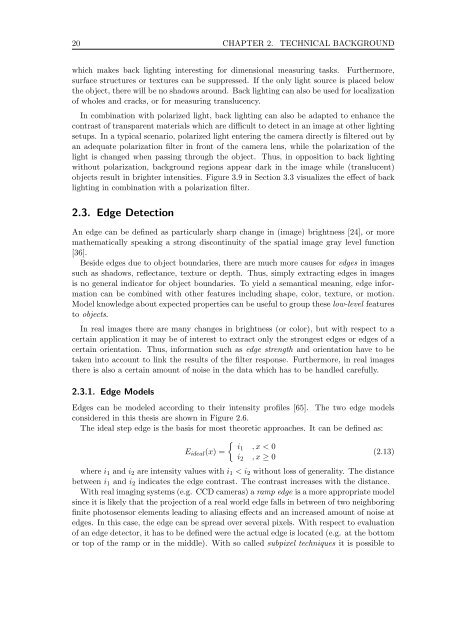Master Thesis - Fachbereich Informatik
Master Thesis - Fachbereich Informatik
Master Thesis - Fachbereich Informatik
You also want an ePaper? Increase the reach of your titles
YUMPU automatically turns print PDFs into web optimized ePapers that Google loves.
20 CHAPTER 2. TECHNICAL BACKGROUND<br />
which makes back lighting interesting for dimensional measuring tasks. Furthermore,<br />
surface structures or textures can be suppressed. If the only light source is placed below<br />
the object, there will be no shadows around. Back lighting can also be used for localization<br />
of wholes and cracks, or for measuring translucency.<br />
In combination with polarized light, back lighting can also be adapted to enhance the<br />
contrast of transparent materials which are difficult to detect in an image at other lighting<br />
setups. In a typical scenario, polarized light entering the camera directly is filtered out by<br />
an adequate polarization filter in front of the camera lens, while the polarization of the<br />
light is changed when passing through the object. Thus, in opposition to back lighting<br />
without polarization, background regions appear dark in the image while (translucent)<br />
objects result in brighter intensities. Figure 3.9 in Section 3.3 visualizes the effect of back<br />
lighting in combination with a polarization filter.<br />
2.3. Edge Detection<br />
An edge can be defined as particularly sharp change in (image) brightness [24], or more<br />
mathematically speaking a strong discontinuity of the spatial image gray level function<br />
[36].<br />
Beside edges due to object boundaries, there are much more causes for edges in images<br />
such as shadows, reflectance, texture or depth. Thus, simply extracting edges in images<br />
is no general indicator for object boundaries. To yield a semantical meaning, edge information<br />
can be combined with other features including shape, color, texture, or motion.<br />
Model knowledge about expected properties can be useful to group these low-level features<br />
to objects.<br />
In real images there are many changes in brightness (or color), but with respect to a<br />
certain application it may be of interest to extract only the strongest edges or edges of a<br />
certain orientation. Thus, information such as edge strength and orientation have to be<br />
taken into account to link the results of the filter response. Furthermore, in real images<br />
there is also a certain amount of noise in the data which has to be handled carefully.<br />
2.3.1. Edge Models<br />
Edges can be modeled according to their intensity profiles [65].<br />
considered in this thesis are shown in Figure 2.6.<br />
The two edge models<br />
The ideal step edge is the basis for most theoretic approaches. It can be defined as:<br />
�<br />
i1<br />
Eideal(x) =<br />
i2<br />
,x














